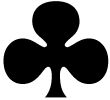Here is the advantage of a major over a minor at its most naked, one might say:
|
|  A K Q 8 7 5 4 A K Q 8 7 5 4 |
|
|
 K 9 K 9 |
|
|
 K 8 K 8 |
|
|
 8 6 8 6 |
|
 9 9 |
|
 J 10 3 J 10 3 |
 J 8 6 5 2 J 8 6 5 2 |
|
 Q 10 4 3 Q 10 4 3 |
 J 9 7 6 3 J 9 7 6 3 |
|
 A Q 10 4 2 A Q 10 4 2 |
 A 5 A 5 |
|
 2 2 |
|
 6 2 6 2 |
|
|
 A 7 A 7 |
|
|
 5 5 |
|
|
 K Q J 10 9 7 4 3 K Q J 10 9 7 4 3 |
|
A self-supporting 7-carder vs. a self-supporting 8-carder that just might be worthless in a spade contract. You're always going to lose a trick to the ace of clubs and a trick to the ace of diamonds. And, as it happens, whatever suit you pick, there's a singleton in a side suit that can lead to a ruff. In a spade contract, the ruffing potential is too obvious to miss. In a club, West leads his singleton, and on getting in with the ace, has to hit his partner with a diamond to get his ruff.
The moral is fairly obvious. If you're only going to make ten tricks, I guess you'd better do it in spades. Furthermore, even those declarers who are allowed a club game won't do as well as their counterparts in 4 spades.
The goat here has to be South. A rebid of two spades here tends to signal a 6-card suit, allowing an 8-card fit. Couldn't North have 5-3-3-2, the doubleton being in clubs? And no stopper in diamonds? Well, by golly, he could at that, couldn't he? But you can't spend your time figuring a worst-case scenario. What about the above suggestion that the club suit might not be runnable in a spade contract? Ditto. It might happen, but you can't spend your days foreseeing unlucky conditions.
Incidentally, I want to emphasize what I've said elsewhere that an 8-card fit is a modest fit and cannot make up for any great shortfall in hcp's. It is when you've got a clear preponderance of the hcp's that an 8-card fit is by and large sufficient to control the hand and develop all the side-suit winners you've got coming. Here, of course, it's a nine-card fit that N-S have in their major.